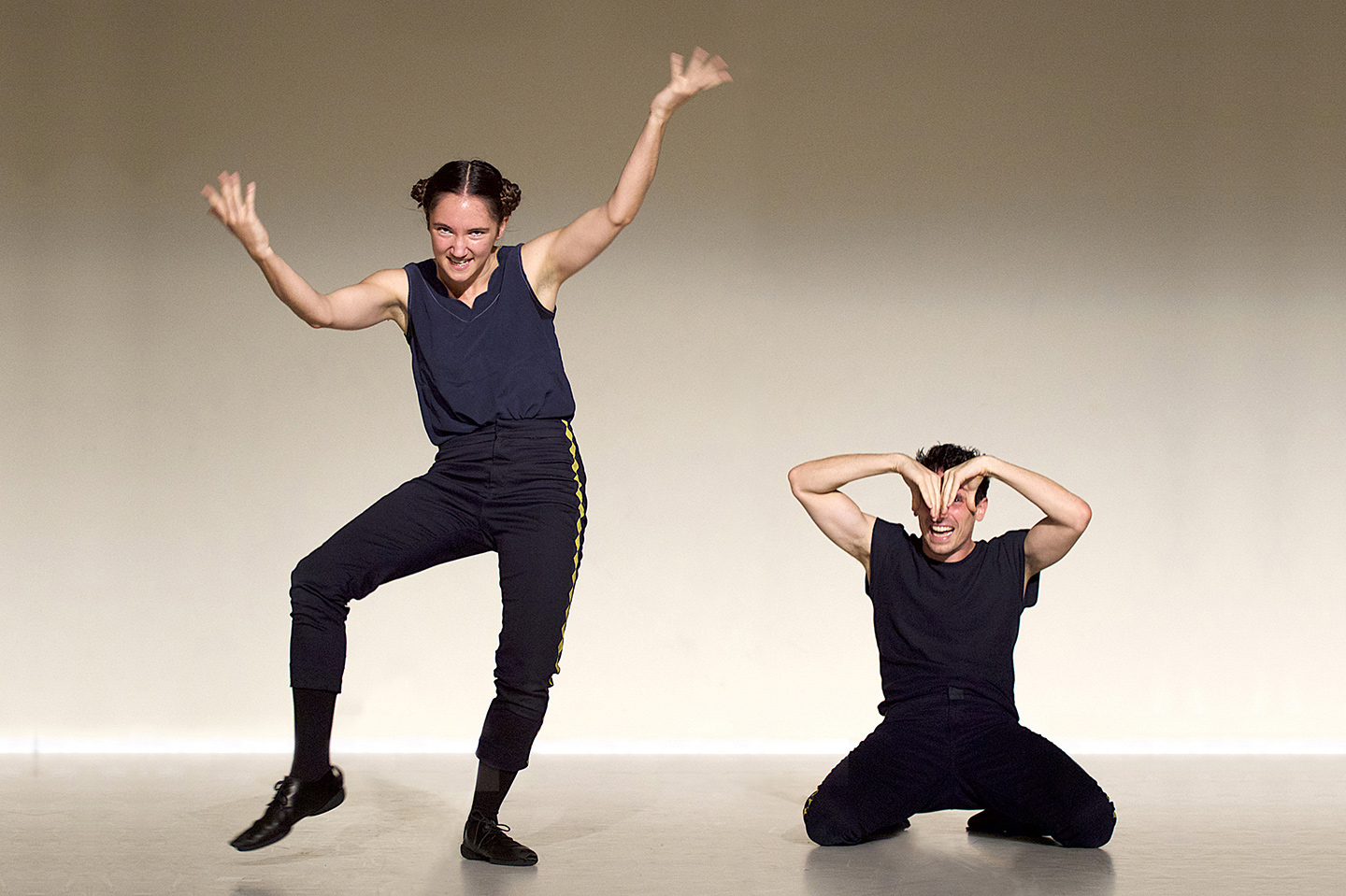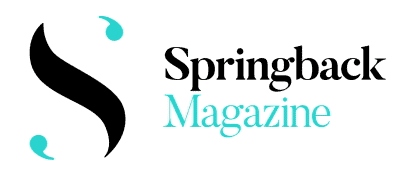Springback Academy 2019
Review

Harleking
Ginevra Panzetti and Enrico Ticconi
This is a story going through history. Telling us what we don’t see, what’s hidden behind reality. Who are the two black-clad people on stage? We don’t know. Their graphic moves, ornamented hand gestures, grins and attitudes might remind you of old illustrated books, commedia dell’arte characters. Allegorical figures who may be talking about you. Inviting you. Manipulating you. These two are actually playing mean tricks and mocking each other. And as the music grows rhythmically in large waves, their silly games seem to turn into something more real. A bit cruel. Dangerous. They have already left scars in history. In a nebula of sounds, broken laughs, cracks and beats, the scene comes closer to us. A fleeting feeling though: as their controlled bodies come back to innocent allegories, the cycle seems to begin again. A never-ending story – yours, maybe?
When Harleking starts, two bodies are sitting collapsed, swaying softly like somnambulists to a soundscape of water and whispers. Is that suppressed laughter or agonized grunting? Oscillating as if drunk, Ginevra Panzetti and Enrico Ticconi show their faces for the first time – as laughing or crying masks.
From the grimacing of commedia dell’arte, these strange harlequins transition to fluid, bird-like yet mechanical movements. Like they’re praying mechanically their hands flick and turn with a mixture of charm and power. A minute later, they freeze in a gesture of Nazi greeting.
At that point, Demetrio Castellucci’s score has shifted to the sound of a conveyor belt and the roar of the crowd at a stadium. The harlequins return to grimacing and laughter. This piece, at once playful and terrifying, suggests that emotional states are also cultural, linking history to the present by showing that violence can be an irresistible game.
Emphasis on king.
Panzetti and Ticcioni invite us into a witty, deconstructive exercise of Harlequin, the diamond-patterned troublemaker of Commedia dell’arte. In a dramaturgically clever and choreographically precise exercise, the Italian duo accompanies the viewer in the discovery of this harle-king, a ‘demon with multiple identities’.
Here a distance is put between the grin, or the spastic physical reaction of Harlequin’s laughter, and the actual thing these elements represent. The king, abstracted, appears in a new form. Consider their take on Venetian masks: Panzetti and Ticcioni draw the ornaments around their eyes, through their arms and above their heads, engaging the whole body in what becomes a hypnotic movement phrase, in canon and with purpose.
Even when the performance falls into a vague, under-illuminated blur, it feels planned: the sudden comeback and the final, political joke of the character land even with more weight because of it. The structure of the work, it seems, was also part of this commedia.
A croaky sound bubbles through the auditorium as two performers sit hunched on the floor, their bodies rippling as if about to vomit. As their impish faces are revealed, we realise that they are in fact locked in an infectious giggle that eventually brings them to their feet.
Proceeding along the back wall, the duo articulate their bodies into courtly poses taken from Commedia Dell’Arte, the form of Italian theatre on which the piece is based. Performing cartoon-like routines, they trick one another, dissolving back into laughter at their own foolishness. But this comedic play doesn’t last long – falling into unison, the dancers caress their faces as if moulding clay into grotesque, gargoyle-like expressions.
Gradually these gestures morph into a series of staccato repetitions of Nazi salutes and dictatorial stances, transforming a light-hearted pantomime into a dark, politically-fuelled warning about underestimating ‘the fool’.
Harleking is like a demonic lifeform that possesses the black-clad bodies of Ginevra Panzetti and Enrico Ticconi, who imitate human emotions in exaggerated gestures and grotesque grimaces with seemingly sinister intent. Crouched on the floor their shoulders shake, whether from laughing or crying, accompanied by the guttural sounds a human voice might make when giggling – or getting water-boarded. A ritualistic warm-up sequence feels meditative and unsettling at once, like a creature summoning its power for dubious means. When they frame their eyes with spread fingers you’d rather not be in the focus of that reptilian gaze. They perform gestures and poses taken from commedia dell’arte, pantomime symbols of emotions – love, hate, sadness, violence – presented with the grandeur of a circus clown, yet manipulative and artificial. Many people have uncomfortable feelings about clowns – the clinical term is coulrophobia – and Harleking very effectively hints towards what toying with emotions for control and power can do.
There’s more to commedia dell’arte than straightforward comedy. In Harleking, Ginevra Panzetti and Enrico Ticconi delve into the sinister side of Harlequin – the perennial servant who would quite like to be king, as this well-crafted piece suggests. In slow motion, the Italian duo’s clownish shtick takes on a sardonic quality, their faces alternately distorting into grins and tearful grimaces; when Panzetti strangles Ticconi on the floor, it looks fleetingly real, until both break into giggles.
Panzetti and Ticconi have been working together for over a decade, and it shows in their meticulous fluidity. Seen side by side, the kaleidoscopic shapes they spin out of simple arm gestures in one scene are a wonder of symmetry. Their characters’ allegiance remains ambivalent: to applause in Demetrio Castellucci’s soundtrack, they go from a Nazi salute to a clenched fist, a symbol of solidarity. That’s the risk of entertaining the highest bidder, and Harleking never forgets it.
Two figures in black, backs towards us, convulse with tremors as if hiccupping or retching uncontrollably – then slowly turn to reveal that their fits are of laughter. Who is the joke on?
In Harleking, Ginevra Panzetti and Enrico Ticconi channel a harlequinade style of mannered gestures and jesterly attitude through jerky, robotic machinations. They project both an air of courtliness and a feeling of profound mistrust. Beckoning fingers invite us closer, backed by exaggerated smiles and flourishes. A sequence of bends and stretches feels like a warm-up of ominous intent. At one moment their actions resolve into a kind of Nazi salute, their fingers semaphoring some other, more cryptic code. At another, Panzetti appears to break Ticconi’s neck and he slumps twitching to the floor. It’s shocking; but shockingly too, they then turn back to us, convulsed by silent sniggers. The joke, oh yes, is on us.

